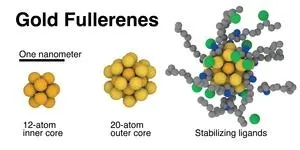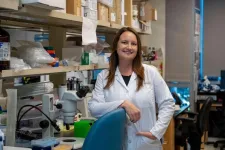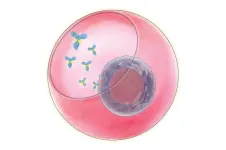(Press-News.org) SAN FRANCISCO, Aug. 15, 2023 — Young vegetables known as microgreens are reputed to be particularly good for health. Now, researchers are trying to find out if microgreens — which can easily be grown at home — are the superfood they’re claimed to be, and how they compare to mature veggies. Results to date show their nutritional profiles differ, as do their effects on gut bacteria. Yet, tests in mice suggest that both microgreen and mature vegetables can limit weight gain.
The researchers will present their results today at the fall meeting of the American Chemical Society (ACS). ACS Fall 2023 is a hybrid meeting being held virtually and in-person Aug. 13–17, and features about 12,000 presentations on a wide range of science topics.
“The scientific literature suggests that cruciferous vegetables, like kale and broccoli, are good for you,” notes Thomas T. Y. Wang, Ph.D., the project’s principal investigator. The microgreen versions of these foods are particularly touted for their health benefits. Older than sprouts but younger than baby greens, microgreens are typically harvested within a couple of weeks after they start growing. And they can easily be grown in a container on a windowsill.
“When we started this research, not a lot was known about the nutrient content or biological effects of microgreens, so we thought we should take a look at them,” says Wang, a scientist at the Agricultural Research Service of the U.S. Department of Agriculture (USDA). He is working with collaborators there and at the University of Maryland, College Park.
The team began their studies with another cruciferous plant — red cabbage. The researchers found that both young and fully grown cabbage limited weight gain in mice fed a high-fat diet. Yet the cabbage’s nutrient profile changed over time, and the microgreen was significantly richer in substances such as glucosinolates — nitrogen- and sulfur-containing compounds that may offer protection from cancer, Wang says.
Next, the scientists turned their attention to kale. “We wondered whether the bioactive components in microgreen kale were different from those in mature kale,” says Wang. “And we found that the nutritional composition is very different.” For example, the immature plant has about five times more glucosinolates. Similarly, further studies by Wang’s team and others have shown that nutrient levels in several other types of cruciferous vegetables are higher in the immature plants.
In their latest work, Wang and his colleagues are comparing the biological effects of microgreen and fully grown kale. They have discovered that both the young plant and mature kale are effective in limiting weight gain in mice fed a high-fat diet. Additional experiments will be needed to see if humans would experience these same benefits.
Wang believes the weight effects in mice may in part be related to the vegetable’s impact on the animals’ “microbiome,” or the community of bacteria in the gut. Consumption of kale, regardless of its maturity, increases the variety of gut bacteria, the researchers have discovered. However, that enhancement is more pronounced with microgreens. That’s important because greater bacterial diversity is generally associated with better health, Wang notes.
In future work, the team will continue to study the impact of other cruciferous plants on health. Those findings could help guide diners who dislike some of these foods but are seeking alternatives that taste better to them. “For instance, for people who don't like broccoli,” Wang says, “can we find some other vegetable they like better that has similar health effects?”
It’s also possible that the flavor profiles of these vegetables could be altered to make them more palatable. Some of the health-promoting constituents responsible for their characteristic flavor — such as glucosinolates — are bitter, but Wang speculates that these compounds might be present at higher levels than are necessary to reap health benefits. If that’s the case, he says, these crops could potentially be bred to reduce those levels and the associated bitterness.
The researchers acknowledge support and funding from USDA and the National Cancer Institute.
A recorded media briefing on this topic will be posted Tuesday, Aug. 15, by 10 a.m. Eastern time at www.acs.org/acsfall2023briefings. Reporters can request access to media briefings during the embargo period by contacting newsroom@acs.org.
For health and safety information for ACS Fall 2023, please visit the FAQ webpage.
The Agricultural Research Service (ARS) is the U.S. Department of Agriculture's chief scientific in-house research agency. Daily, ARS focuses on solutions to agricultural problems affecting America. Each dollar invested in agricultural research results in $20 of economic impact.
The American Chemical Society (ACS) is a nonprofit organization chartered by the U.S. Congress. ACS’ mission is to advance the broader chemistry enterprise and its practitioners for the benefit of Earth and all its people. The Society is a global leader in promoting excellence in science education and providing access to chemistry-related information and research through its multiple research solutions, peer-reviewed journals, scientific conferences, eBooks and weekly news periodical Chemical & Engineering News. ACS journals are among the most cited, most trusted and most read within the scientific literature; however, ACS itself does not conduct chemical research. As a leader in scientific information solutions, its CAS division partners with global innovators to accelerate breakthroughs by curating, connecting and analyzing the world’s scientific knowledge. ACS’ main offices are in Washington, D.C., and Columbus, Ohio.
To automatically receive press releases from the American Chemical Society, contact newsroom@acs.org.
Note to journalists: Please report that this research was presented at a meeting of the American Chemical Society.
Follow us: Twitter | Facebook | LinkedIn | Instagram
Title
Differential modulatory effects of kale microgreen and mature kale on the gut microbiome
Abstract
Interest in healthy living lifestyles has promoted the emergence of many new purported healthy foods, such as microgreens, in the market. Microgreens are young vegetables, different from baby greens and sprouts, harvested ~7-21 days after the cotyledon leaves appeared. However, relatively less is known of the health benefit of microgreens and this warrants further elucidation. Recent advances also indicate modulation of the gut microbiome may contribute to health effects in human. The literature on the effects of kale microgreen as well as mature kale on the gut microbiome remain scarce. In this study, the effects of kale (Darkibor variety) microgreen and its mature counterpart on the gut microbiome were examined to provide science-based information for the emerging new food. Using a mouse model of diet-induced obesity, animals (C57BL mice) were fed with diets contain low fat (10%, LF)) or high fat (45%, HF), supplemented with or without Kale microgreen (KMG) or mature kale (MK) in the perspective diet matrix for 8 weeks. After feeding, cecal content was harvested and subject to 16S rRNA amplicon sequencing followed by bioinformatic analysis. Consumption of KMG and KG significantly attenuated HF diet induced weight gain in mice. Consumption of KMG or MK leads to changes of alpha and beta-diversity in the gut microbiome. However, MK was less effective in modulating the alpha diversity in a low fat matrix. Further analysis also identified as a potential biomarker, an unidentified Ruminococcus species, to be correlated with KMG and MK consumption in both low fat and high matrix. Overall, our results support modulatory effect of consuming kale microgreen on the gut microbiome which appeared to be different from the effects exerted by MK; and diet matrix may also influence manifestation of an effect exerted by vegetables.
END
Microgreens and mature veggies differ in nutrients, but both might limit weight gain
2023-08-15
ELSE PRESS RELEASES FROM THIS DATE:
Detecting risk of metastatic prostate cancer in Black men
2023-08-15
SAN FRANCISCO, Aug. 15, 2023 — To explore why prostate cancer disproportionately sickens and kills Black men, researchers are looking to another disorder, diabetes, which alters metabolism. They used this approach in a preliminary clinical trial and today report the identification of four metabolism-related biomarkers linked to an increased risk of metastatic prostate cancer in men of West African heritage. This discovery could lead to improved testing and treatments for these patients.
The researchers will present their results at the fall ...
City of Hope researchers identify biomarkers that may detect risk of advance prostate cancer in Black men
2023-08-15
LOS ANGELES — Scientists at City of Hope, one of the largest cancer research and treatment organizations in the United States and a leading research center for diabetes and other life-threatening illnesses, have identified a cell metabolism process found in men with diabetes and metastatic prostate cancer that could one day lead to improved testing and treatments for Black men with these diseases. The research will be highlighted in the press program for the American Chemical Society (ACS) Fall 2023, a hybrid meeting that ...
Scientists pinpoint the microbes essential to making traditional mozzarella
2023-08-15
Mozzarella is far more than just a pizza topping. A unique Italian cheese, buffalo mozzarella from Campania has been recognized as a delicacy and protected under EU law for nearly 30 years. But what makes this mozzarella so special? The ingredients are simple: water buffalo milk, rennet, and natural whey starter, processed using fresh water and brine. But the natural whey starter contains microbes that are crucial to developing the mozzarella. Scientists from Italy used high-throughput 16S rRNA amplicon ...
Teachers perceive more conflict with Black boys, closer relationships with white girls
2023-08-15
A team of researchers led by a Virginia Commonwealth University professor found that teachers, regardless of race, perceived the most conflict with Black boys and the least conflict with white girls in their classrooms. Teachers also perceived their relationships with Black boys as increasing in conflict at higher rates than with white and female children across kindergarten through second grade, according to findings published this summer in the Journal of School Psychology.
The study analyzed nationally representative survey data from 9,190 participants – teachers who evaluated relationships ...
Novel biologic Ab-IPL-IL-17™ shows promise for rheumatoid arthritis and inflammatory bowel disease
2023-08-15
Researchers have shown that a novel antibody generated to target an 'essential amino acid sequence’ of both interleukin-17A and F has greater activity and potentially fewer side effects than existing biological therapies for conditions such as as rheumatoid arthritis (RA), psoriasis, and inflammatory bowel disease (IBD).
The antibody, called Ab-IPL-IL-17™, targets a specific section of signalling proteins IL-17A and IL-17F which play a central role in sustaining inflammation during onset and ...
Scientists explore dinosaur ‘coliseum’ in Denali National Park
2023-08-15
University of Alaska Fairbanks scientists have discovered and documented the largest known single dinosaur track site in Alaska. The site, located in Denali National Park and Preserve, has been dubbed “The Coliseum” by researchers.
The Coliseum is the size of one-and-a-half football fields and contains layer upon layer of prints preserved in rock. The site is a record of multiple species of dinosaurs over many generations that thrived in what is now Interior Alaska nearly 70 million years ago. The scientists describe the site in a paper recently published ...
Dogs can detect COVID-19 infections faster and more accurately than conventional technology, demonstrating readiness for mainstream medical applications
2023-08-15
It’s an idea that has finally gained scientific consensus: Dogs can be a faster, more precise, less expensive — not to mention friendlier — method of detecting COVID-19 than even our best current technology. A growing number of studies over the last two or so years has highlighted the power of dogs in detecting the stealthy virus and its variants, even when they are obscured by other viruses, like those from common colds and flu.
“It went from four papers to 29 peer-reviewed studies — that includes more than 400 scientists from over 30 countries and 31,000 samples,” said UC Santa Barbara Distinguished Professor Emeritus Tommy Dickey, who with ...
Images of enzyme in action reveal secrets of antibiotic-resistant bacteria
2023-08-15
Bacteria draw from an arsenal of weapons to combat the drugs intended to kill them. Among the most prevalent of these weapons are ribosome-modifying enzymes. These enzymes are growing increasingly common, appearing worldwide in clinical samples in a range of drug-resistant bacteria.
Now scientists have captured the first images of one important class of these enzymes in action. The images show how the enzymes latch onto a particular site on the bacterial ribosome and squeeze it like a pair of tweezers to extract an RNA nucleotide and alter it. The Proceedings of the National Academy of Sciences (PNAS) published the findings, led by scientists at Emory University.
The advanced technique ...
USC Stem Cell mouse studies tune into hearing regeneration
2023-08-14
A deafened adult cannot recover the ability to hear, because the sensory hearing cells of the inner ear don’t regenerate after damage. In two new studies, partially funded by the National Institutes of Health and published in the Proceedings of the National Academy of the Sciences (PNAS), USC Stem Cell scientists explain why this is the case and how we might be able to change it.
“In the non-sensory supporting cells of the inner ear, key genes required for conversion to sensory cells are shut off through a process known as ‘epigenetic silencing.’ By studying how the genes are shut off, we begin to understand how we might turn ...
Scientists identify genes linked to high production of key antibody
2023-08-14
A collaboration led by UCLA and the Seattle Children’s Research Institute has yielded new knowledge about the genes responsible for the production and release of immunoglobulin G, the most common type of antibody in the human body.
The finding has the potential to advance manufacturing of antibody-based therapies for diseases such as cancer and arthritis, as well as the development of medical treatments that rely on the production of antibodies.
Antibodies are a group of proteins that are crucial to the immune system. Immunoglobulin G, or IgG, ...






